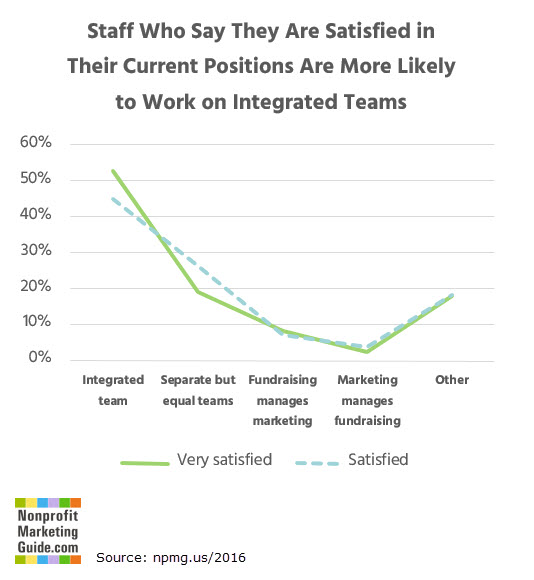
We need to break down the barriers preventing fundraising and marketing staff from cooperating in order to get the best results. The advice to get rid of “silos” is nothing new.
But we have some new data in the 2016 Nonprofit Communications Trends Report that adds a few more good reasons why your nonprofit should consider this kind of reorganization.
In 39% of nonprofits, you’ll find an integrated team, with marketing and fundraising working together on an equal level under the same manager. In 37% of nonprofits, you’ll find separate marketing and fundraising teams with different managers, but with equal authority within the organization.
While the percentage of “integrated” teams versus “separate but equal” teams is similar, we found some stark differences.
Our research shows a correlation between the structure of communications and fundraising teams and how responsible individuals personally feel for achieving both fundraising and community engagement goals.
Nonprofit staff on integrated teams where marketing and fundraising staff work together on an equal level under the same manager were four times as likely to say they felt directly responsible for fundraising goals as those working on separate teams with different managers. Members of integrated teams were twice as likely to feel responsible for community building and engagement goals.
Job satisfaction is also significantly higher among staff on integrated teams.
Looking across all staff who say they are “very satisfied” in their positions, 53% work on integrated teams and 19% work on separate but equal teams.
Looking only at staff who work on integrated teams, 32% say they are “very satisfied,” compared to 21% on separate but equal teams.
I’d say staff feeling more responsible for results and liking the work more are two nice benefits. While we can’t prove cause-and-effect with this data, the correlation is there, and it certainly makes sense.
What about other management structures? In 11% of nonprofits a fundraising manager is in charge of marketing staff; in 3% of organizations, a marketing manager is in charge of fundraising staff. 11% of survey participants selected other structures, indicating that they do not fundraise, don’t have any formal management structure, or one person does it all.
Do you think your organization should reorganize the way that marketing and fundraising staff work together? Would it make a difference? We’d love to hear your thoughts in the comments.







